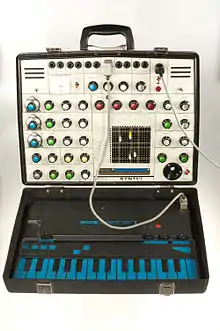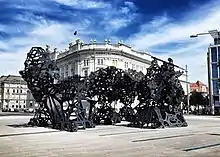Peter Zinovieff
Peter Zinovieff (born 26 January 1933) is a British engineer and composer, whose EMS company made the VCS3 synthesizer in the late 1960s. The synthesizer was used by many early progressive rock bands such as Pink Floyd[3] and White Noise, and Krautrock groups[4] as well as more pop-oriented artists, including Todd Rundgren and David Bowie. He continues to work as a composer of electronic music.
Peter Zinovieff | |
|---|---|
| Born | 26 January 1933[1] |
| Education | Guildford Royal Grammar School Gordonstoun School |
| Alma mater | Oxford University |
| Occupation | Engineer, inventor and composer |
| Known for | Co-founder, EMS |
| Spouse(s) | Victoria Heber-Percy (m. 1960) Rose Verney (m. 1978) |
| Children | 7, including Sofka Zinovieff |
| Parent(s) | Leo Zinovieff Sofka, née Princess Sophia Dolgorouky |
| Relatives | Robert Heber-Percy (father-in-law) |
Early life and education
Zinovieff was born on 26 January 1933;[5] his parents, Leo Zinovieff and Sofka, née Princess Sophia Dolgorouky, were both Russian aristocrats, who met in London after their families had emigrated to escape the Russian Revolution and soon divorced.[6] During World War II he and his brother Ian lived with their grandparents in Guildford and then with their father in Sussex. He attended Guildford Royal Grammar School, Gordonstoun School and Oxford University, where he earned a doctorate in geology.[7][8]
Career in music and electronics
Zinovieff's work followed research at Bell Labs by Max Mathews and Jean-Claude Risset, and an MIT thesis (1963) by David Alan Luce.[9] In 1966–67, Zinovieff, Delia Derbyshire and Brian Hodgson ran Unit Delta Plus, an organisation to create and promote electronic music. It was based in the studio Zinovieff had built, in a shed at his house in Putney. (The house is near the Thames, and the studio was later partially destroyed by a flood).[10][11] EMS grew out of MUSYS, which was a performance controller operating as an analogue-digital hybrid.[12] It was a synthesiser system which Zinovieff developed with the help of David Cockerell and Peter Grogono, and used two DEC PDP-8 minicomputers and a piano keyboard.[13] Unit Delta Plus ran a concert of electronic music at the Watermill Theatre in 1966, with a light show. In early 1967 they performed in concerts at The Roundhouse, at which the Carnival of Light was also played; they split up later in 1967.[11] Paul McCartney had visited the studio, but Zinovieff had little interest in popular music.[14]
In 1968, part of the studio was recreated at Connaught Hall, for a performance of pieces by Justin Connolly and David Lumsdaine.[15] At the IFIP congress that year, the composition ZASP by Zinovieff with Alan Sutcliffe took second prize in a contest, behind a piece by Iannis Xenakis.[16]

In 1969, Zinovieff sought financing through an ad in The Times but received only one response, £50 on the mistaken premise it was the price of a synthesiser. Instead he formed EMS with Cockerell and Tristram Cary.[17] At the end of the 1960s, EMS Ltd. was one of four companies offering commercial synthesizers, the others being ARP, Buchla, and Moog.[18] In the 1970s Zinovieff became interested in the video synthesizer developed by Robert Monkhouse, and EMS produced it as the Spectron.[19]
Jon Lord of Deep Purple described Zinovieff as "a mad professor type": "I was ushered into his workshop and he was in there talking to a computer, trying to get it to answer back".[20] Trevor Pinch and Frank Trocco, in their history of the synthesizer revolution, see him rather as aristocratically averse to "trade".[21]
Zinovieff wrote the libretto for Harrison Birtwistle's opera The Mask of Orpheus,[22] and also the words for Nenia: The Death of Orpheus (1970).[23] The section Tristan's Folly in Tristan (1975) by Hans Werner Henze included a tape by Zinovieff.[24]
Activity as a composer (2010 to present)
After a break of many years, in 2010 Zinovieff became active again publicly in music composition.[25]

This started with a commission from TBA21, instigated by Russell Haswell,[26] to create an audio work for the large-scale installation The Morning Line by artist Matthew Ritchie, which contains a 47-speaker spatial sound system. The result was Bridges from Somewhere and Another to Somewhere Else,[27] shown during its exhibition in Istanbul. A second piece Good Morning Ludwig was commissioned in 2012 when the installation moved permanently to ZKM, Karlsruhe.[28]
Since then Zinovieff has continued to work primarily as a composer.[27][29] His new work combines sounds from live instrumentation and field recordings and continues his long-term interest in computer music and spatial multi-channel performance setups.[29][26] Embracing the power of modern computer technology has allowed him to realise ways of working he has pursued throughout his career in music and electronics.[25][30]
With violinist Aisha Orazbayeva he has composed two concertos for violin and electronics: OUR (2010)[25] and Our Too, premiered at London Contemporary Music Festival in 2014.[29]
An ongoing series of works in collaboration with poet Katrina Porteous combine poetry with soundscapes created by Zinovieff using sound sources related to physics and astronomy.[31] The first piece, Horse (2011), was broadcast on BBC Radio 3. Subsequent works with Porteous have been commissioned by the Centre for Life, Newcastle upon Tyne for live performance in its planetarium.[32] These pieces — Edge (2013),[33] Field (2015),[34] Sun (2016)[35] — are surround-sound works with live visuals created by planetarium supervisor Christopher Hudson.[34] A further work in the series, focusing on recordings of Antarctic glaciers, is in progress as of 2019.[36]
His collaboration with cellist Lucy Railton, entitled RFG,[29] was initially conceived as a live piece for a spatially configured loudspeaker system and performed between 2016–17.[37][38] An album version was released as RFG Inventions for Cello and Computer on PAN in 2020.
A retrospective compilation covering his work in the EMS era, including collaborations with Hans Werner Henze and Harrison Birtwistle, was compiled by musician Pete Kember and released in 2015.
In 2015 he was awarded an honorary Doctor of Music degree by Anglia Ruskin University.[39]
Personal life
In 1960, Zinovieff married Victoria Heber-Percy, daughter of Robert Heber-Percy and Jennifer Ross; in 1978, he married Rose Verney. He has seven children and eight grandchildren.[40]
Selected discography
Solo and collaborative works
with Harrison Birtwistle
with Harrison Birtwistle, Hans Werner Henze and others
- 2015 Electronic Calendar – The EMS Tapes (Space Age Recordings)
with Aisha Orazbayeva
- 2011 5 Bagatelles From OUR Violin And Computer Concerto (on Aisha Orazbayeva Outside LP on Nonclassical)[42]
with Lucy Railton
- 2020 RFG Inventions for Cello and Computer (PAN)
Compilation appearances
- 1968 Cybernetic Serendipity Music (ICA)[43]
- 2008 Recovery/Discovery 40 years of surround electronic music in the UK (Sound And Music)[44]
Notes
- "Peter Zinovieff - New Songs, Playlists & Latest News - BBC Music". BBC. Retrieved 19 December 2019.
- England & Wales, Civil Registration Birth Index, 1916–2007
- Notably on The Dark Side of the Moon: Trevor Pinch and Frank Trocco, Analog Days, Harvard University Press, 2004, ISBN 0-674-01617-3, p. 293.
- Pinch and Trocco, p. 297.
- Sofka Zinovieff, Red Princess: A Revolutionary Life, London: Granta, 2007, ISBN 978-1-86207-919-9, p. 185.
- Pinch and Trocco, pp. 276, p. 278.
- Zinovieff, p. 295.
- Pinch and Trocco, p. 279.
- Curtis Roads (January 1996). The Computer Music Tutorial. MIT Press. pp. 547–8. ISBN 978-0-262-68082-0.
- Zinovieff, pp. 327–28: "by the end of the 1960s, Peter had three children and ran an electronic music studio from a garden shed by the river in Putney".
- Unit Delta Plus at delia-derbyshire.org, retrieved 6 January 2015.
- "EMS Synthesisers, Peter Zinovieff, Tristram Cary, David Cockerell United Kingdom, 1969, 120 Years of Electronic Music". 30 January 2014. Retrieved 6 January 2015.
- "Zinovieff with VC3 in his garden". Archived from the original on 7 August 2011. Retrieved 25 January 2011.
- Mark Brend (6 December 2012). The Sound of Tomorrow: How Electronic Music Was Smuggled into the Mainstream. Bloomsbury Publishing. pp. 4–5. ISBN 978-1-62356-529-9.
- Anthony Gilbert, SPNM Composers' Weekend, The Musical Times Vol. 109, No. 1508 (Oct., 1968), p. 946. Published by: Musical Times Publications Ltd. Stable URL: https://www.jstor.org/stable/953598
- Michael Kassler, Report from Edinburgh, Perspectives of New Music Vol. 7, No. 2 (Spring - Summer, 1969) , pp. 175-177. Published by: Perspectives of New Music. Stable URL: https://www.jstor.org/stable/832302
- "All About EMS: Part 1", Musical Matrices, Sound on Sound November 2000, retrieved 19 April 2010.
- Peter Manning (2004). Electronic and Computer Music. Oxford University Press. p. 201. ISBN 978-0-19-514484-0.
- Chris Meigh-Andrews, Peter Donebauer, Richard Monkhouse and the Development of the EMS Spectron and the Videokalos Image Processor, Leonardo Vol. 40, No. 5 (2007) , pp. 463-467, 450-451, at p. 463. Published by: The MIT Press. Stable URL: https://www.jstor.org/stable/20206483
- Pinch and Trocco, p. 293.
- Pinch and Trocco, p. 300.
- Michael Kennedy (22 April 2004). The Concise Oxford Dictionary of Music. Oxford University Press. p. 459. ISBN 978-0-19-860884-4.
- David Wright and Harrison Birtwistle, Clicks, Clocks & Claques. David Wright Investigates Cliques and the Claques in the Music of Birtwistle, 60 This Month, The Musical Times Vol. 135, No. 1817 (Jul., 1994) , pp. 426-431, at p. 430. Published by: Musical Times Publications Ltd. Stable URL: https://www.jstor.org/stable/1003251
- R. H. Bales, Review, Tristan by Hans Werner Henze, Computer Music Journal Vol. 8, No. 2 (Summer, 1984), p. 63. Published by: The MIT Press. Stable URL: https://www.jstor.org/stable/4617906
- Hall, Tom (Spring 2013). "Peter Zinovieff and Cultures of Electronic Music" (PDF). PAGE: Bulletin of the Computer Arts Society. 69.
- Beaumont-Thomas, Ben (20 October 2015). "Interview: Peter Zinovieff: 'I taught Ringo to play synth. He wasn't very good – but neither was I'". The Guardian. London, UK. Retrieved 2 May 2020.
- Neset, Anne Hilde (August 2010). "Cross Platform - The Morning Line". The Wire. 318: 26–27.
- "Peter Zinovieff | Good Morning Ludwig, 2012". TBA21. 2012. Retrieved 2 May 2020.
- Barry, Robert (17 August 2016). "Interview: Lucy Railton & Peter Zinovieff". The Quietus. Retrieved 2 May 2020.
- Helliwell, Ian (2016). Tape leaders : a compendium of early British electronic music composers. Cambridge: Sound On Sound. ISBN 978-0-9954958-0-7. OCLC 962031940.
- Porteous, Katrina (2019). Edge. Hexham, Northumberland: Bloodaxe Books. ISBN 978-1-78037-490-1. OCLC 1090281455.
- "Poetry Readings by BBC Broadcasters Julian May and Katrina Porteous". Lewis and Clark University. Retrieved 2 May 2020.
- "Poetry Please Special: Edge". Poetry Please. 15 December 2013. BBC Radio 4.
- "INTERVIEW: Katrina Porteous on Field | NARC. | Reliably Informed | Music and Creative Arts News for Newcastle and the North East". narcmagazine.com. Retrieved 5 September 2020.
- "Imagining the Sun". NUSTEM. Retrieved 5 September 2020.
- Alikivi, Gary (27 April 2019). "SOME KIND OF MAGIC with Northumberland poet, writer & broadcaster Katrina Porteous". ALIKIVI. Retrieved 5 September 2020.
- "Peter Zinovieff and Lucy Railton: RFG". City, University of London. 22 November 2016. Retrieved 2 May 2020.
- "Releases | PAN". PAN. 2020. Retrieved 2 May 2020.
- "Home | Alumni and supporters | Honorary award holders | Peter Zinovieff". Anglia Ruskin University. 2015. Retrieved 1 May 2020.
- Peter Zinovieff on thepeerage.com, 20 November 2008, accessed 18 April 2010.
- Pinsent, Ed (17 February 2009). "Chronometer Recovered – The Sound Projector". www.thesoundprojector.com. Retrieved 19 June 2020.
- "Aisha Orazbayeva - Outside". Discogs. Retrieved 5 September 2020.
- "Cybernetic Serendipity Music". The Vinyl Factory. Retrieved 19 June 2020.
- Recovery/Discovery 40 years of surround electronic music in the UK., London: Sound and Music, 2008, OCLC 638211038, retrieved 5 July 2020
Further reading
- Sofka Skipwith. Sofka, the Autobiography of a Princess. London: Hart-Davis, 1968. OCLC 504549593. Autobiography by his mother.
- Sofka Zinovieff. Red Princess: A Revolutionary Life. London: Granta, 2007. ISBN 978-1-86207-919-9. Biography of his mother by his daughter.
External links
- Dr. Peter Zinovieff, 7 Deadly Synths – Lecture for the Red Bull Music Academy, London 2010
- Matthew Bate, What the Future Sounded Like – Three-part Australian video about EMS & personnel
- Graham Hinton, The EMS Story, 2002
- Peter Zinovieff at IMDb
